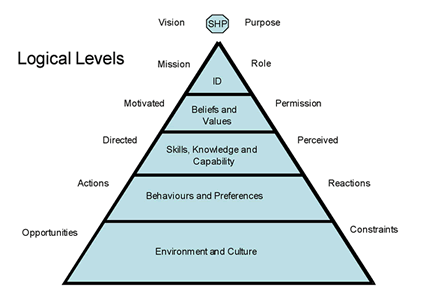logical levels - the extended model

The Extended Model of Logical Levels reveals something about the nature of being 'within the model' as it is possible to operate with a 'left' or 'right' hand orientation within each of the levels.
What questions the model helps us address
This extension to the original model describes the nature of an individual’s relationship to the Logical Levels architecture. It gives us further insight into the dominant and preferred styles of operation that affect not only how we feel and how we think about ourselves but also our preferred style influences the nature and quality of our relationship with others and their relationships with us.
The extended logical levels models create genuine insights for those struggling with talent management, leadership deployment and development and a wide range of dysfunctional relationships within organisations.
The left hand side of the triangle describes a style of operation that is active whilst the right hand side describes a way of being that is more re-active in character.
Within environment an individual can either view the world through the lens of opportunities or through the lens of constraints.
An opportunities based person sees what might be possible and explores that actively and positively. Constraints based individuals will see what might go wrong and will express those observations in a more risk adverse style.
In behaviours an individual can either operate in a manner which denotes action or can operate in a manner which requires someone else to act first - thus creating a reaction.
An action based person simply does what they believe needs to be done. A reaction based person knows what needs to be done but usually waits until something happens before declaring their view and taking action.
In skills, capability and knowledge an individual can either use their capabilities in a directed way or they can store up their capabilities and have a perceived sense of their new skills.
A directed person learns something new and begins to integrate it into their way of operating almost immediately. A perception based person gathers up the knowledge and uses the information as knowledge rather than translating it into shifts in behaviour or attitude.
In beliefs and values an individual can either be motivated by what they believe or they can wait for permission (from someone else or themselves) to operate within their beliefs and values,
A motivated person declares and demonstrates their beliefs and values in almost everything they do and say. A permission based person holds back on declaring their beliefs and values until a situation develops where they feel as if they have been given permission to declare their feelings.
In identity an individual can be either engaged in a mission or they can be engaged in a role.
A mission based person articulates what they are trying to achieve or accomplish. A role based person tends to talk about and do what is described within their role or task.
In sense of higher purpose an individual can either be engaged in a visionary view of what they are trying to achieve or they can be engaged in a more purposeful view of their desire to achieve outside of themselves.
A vision based person would describe something dramatic and extraordinary. A purpose based person would describe their objective in a more factual way, eg. using the language of a project plan - describing the steps and the milestones along the way.
There is no value judgement about left and right. As a leader it is important to be aware of where we are on the model and mindful of where other people may be in order that we can use ourselves in such a way that we maximise our leadership impact.
